What Soviet self-propelled guns were "St. John's wort"? Analysis of anti-tank capabilities of domestic self-propelled guns
The first Soviet self-propelled gun with a pronounced anti-tank orientation was the SU-85. This machine is built on the basis of medium tank T-34, as a whole, was quite consistent with its purpose. But in the second half of the war, the SU-85 armor no longer provided the necessary protection, and the 85-mm gun could provide confident penetration of the frontal armor of heavy German tanks at a distance of no more than 800 m. In this connection, the question arose of creating a self-propelled artillery mount capable of equal to resist all existing and promising enemy tanks.
The results of the shelling at the range of captured German heavy tanks showed that to significantly increase armor penetration, it is necessary to increase the initial velocity of an 85-mm caliber armor-piercing projectile to 1050 m / s or to use subcaliber shells with carbide core. However, the creation of a new shot with an increased weight of the powder charge in wartime was considered impossible, and the mass production of sub-caliber shells required an increased consumption of scarce cobalt and tungsten. Tests showed that for the confident destruction of heavy German tanks and self-propelled guns, a gun of at least 100 mm caliber was required. By that time, the 107-mm tank gun ZIS-6 (based on the M-60 divisional cannon) was created in the USSR. But the ZIS-6, like the M-60, had a separate-shell loading, which limited the rate of fire. In addition, the production of the M-60 was stopped in 1941, and the tank version was still not finalized. Therefore, for a new anti-tank self-propelled gun, it was decided to design a gun using unitary shots of a 100-mm B-34 sea universal gun. The marine system initially had unitary loading, and the B-34 shell had a higher initial velocity. The difference between armor-piercing shells for the B-34 and M-60 turned out to be less than two kilograms. However, the creation of a tank 100-mm guns with acceptable overall dimensions proved to be a daunting task. In early 1944, under the leadership of F.F. Petrov, a new 10-mm gun D-100S was created on the basis of the D-10 sea anti-aircraft gun. The D-10S gun was lighter than its competitors and could be placed on the chassis of the T-34 medium tank without significant changes and unnecessary weight increase.
SU-100 self-propelled artillery mount
In February 1944, tests of the self-propelled artillery mount SU-100 began, during which 1040 rounds were fired and 864 km were completed. When creating the SU-100, the designers of Uralmashzavod used the achievements of the modernized SU-85, created at the end of 1943. The crew of the SU-100 compared to the SU-85 has not changed, but many significant improvements have been made, of which the appearance of the commander’s turret was the most noticeable. However, when developing a new tank destroyer, the caliber of the gun was not only increased. To provide protection against the most common German 75 mm Pak 40 and Kw.K.40 L / 48 guns, the thickness of the upper frontal sheet and the driver’s hatch increased to 75 mm at an angle of inclination of 50 °. The thickness of the side armor remained the same - 45 mm. The thickness of the gun’s mask was 100 mm. The double-leaf hatch for the panorama in the roof of the hull has changed a lot, also the MK-IV periscope device has appeared in its left wing. Inspection periscope devices around the cabin were removed, but an exhaust fan returned to the roof. They refused to tilt the stern leaf, which increased the volume of the fighting compartment. The overall design of the gun installation was similar to the SU-85. Also, the left front fuel tank was removed from the fighting compartment, and the suspension of the front track rollers was strengthened. Ammunition compared to the SU-85 decreased by almost a third, to 33 rounds. The gun was mounted in the front plate of the wheelhouse in a cast frame on double trunnions, allowing its guidance in the vertical plane in the range from −3 to + 20 ° and in the horizontal ± 8 °. When shooting direct fire, guidance on the target was carried out using the telescopic articulated sight TSh-19, and from closed positions - using the Hertz panorama and side level. During the tests, a rate of fire of up to 8 rds / min was obtained. The practical rate of fire of the gun was 4-6 rds / min.
A 100-hp V-2-34 diesel engine was installed on the SU-500, thanks to which the self-propelled guns weighing 31,6 tons could reach speeds of up to 50 km / h on the highway. Speed on a march along a dirt road usually did not exceed 25 km / h. The capacity of the internal fuel tanks was 400 liters, which provided the car with a cruising range of 310 km on the highway. Cruising cross country - 140 km.
The standard for the serial SU-100 was the second prototype, on which the main shortcomings identified during the tests were eliminated. Instead of perforated track rollers, continuous bandages with greater survivability began to be used. Two smoke bombs were fastened to the upper stern sheet of the hull. Also on the roof of the wheelhouse, to the right of the hatch under the panorama, a cap appeared on which a new gun stop was attached in a marching manner. The thickness of the armor of the commander’s turret was brought to 90 mm.
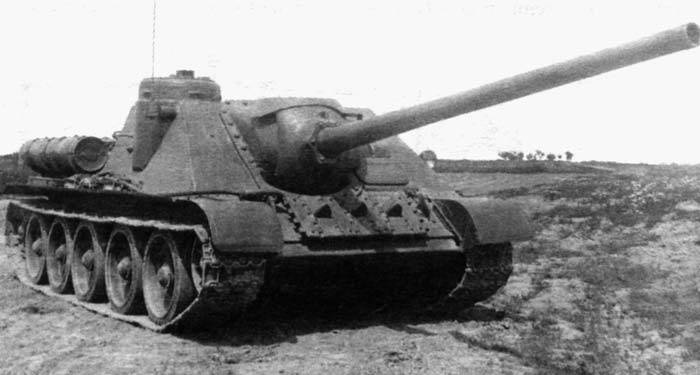
On July 3, 1944, GKO Decree No. 6131 was issued on the adoption of the SU-100 for service. The first batch of 40 cars was delivered to the military in September 1944.
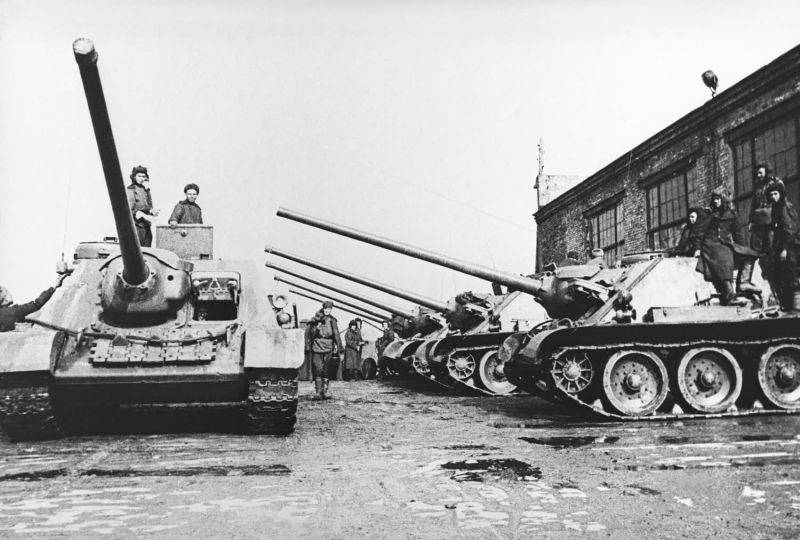
During the front-line tests, the self-propelled gun was highly appreciated, but deliveries to self-propelled artillery regiments had to be postponed for several months due to the lack of mass production of 100-mm armor-piercing shells. By the way, the same problem was encountered during the combat use of the BS-3 field guns. At first, in their ammunition there were only unitary shots with high-explosive fragmentation grenades. In connection with the forced delay in the production of the SU-100, the transitional installation, the SU-85M, went into the series. This car was produced from September to November 1944 and was a “hybrid” of the SU-100 chassis and the SU-85A weapons.
Since the development of the production of armor-piercing projectile BR-412B was delayed until October 1944, the first self-propelled guns entered training centers. Only in November regiments equipped with the SU-100 were formed and sent to the front. The staffing of the SAP was the same as the regiments that had SU-85. The regiment totaled 318 people and had 21 self-propelled guns (20 vehicles in 5 batteries and 1 self-propelled gun of the regiment commander). At the end of the year, the first self-propelled artillery brigades (SABR) were formed on the basis of individual tank brigades: 207th Leningradskaya, 208th Dvinskaya and 209th. The main reasons for the formation of the SABR were difficulties with the management and organization of supply of EPS, the number of which by the end of 1944 exceeded two hundred. The brigade had 65 SU-100 and 3 SU-76M.
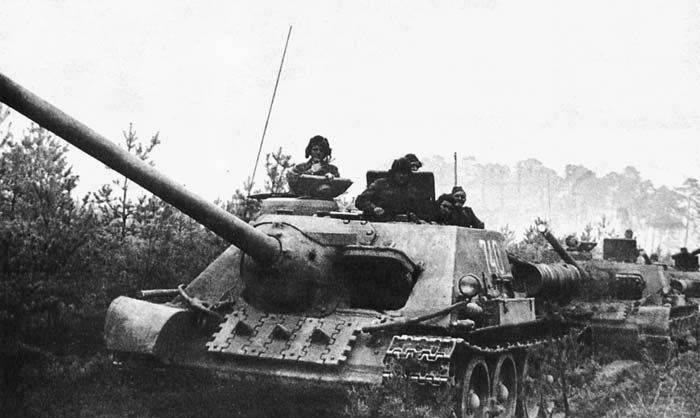
For the first time, the SU-100 was massively used in battle in January 1945 during the Budapest operation. Given the fact that the Red Army by the beginning of 1945 was sufficiently saturated with anti-tank artillery, new T-34-85 and IS-2 tanks, as well as self-propelled guns SU-85, ISU-122 and ISU-152, very effective in anti-tank the new SU-100 self-propelled guns did not have much impact on the course of hostilities. In addition, the normal operation of the SU-100 at first was prevented by a number of design and manufacturing defects. On some machines, cracks appeared in the welds of the hull and there was a destruction of the details of the gun mount during firing. Despite the fact that, based on the operating experience of the SU-122 and SU-85, the road wheels strengthened and also made improvements to the suspension design, there was increased wear on the first pair of road wheels. Not only the bandages were destroyed, but also cracks in the disks were found. As a result, it was necessary to simultaneously supply the parts with new track rollers and develop a reinforced front track roller and its balancer.
New self-propelled guns really showed themselves on January 11, when German tanks of up to 100 units, supported by infantry, launched a counterattack. On that day, the forces of the 1453th and 1821st SAPs burned 20 enemy tanks. At the same time, along with high anti-tank qualities, it was revealed that the SU-100 is more vulnerable to anti-tank infantry means than tanks. This was due to the fact that the self-propelled guns initially did not have machine gun weapons, and pointing the gun at close targets required turning the hull. Due to the fact that the barrel length of the D-10C gun exceeded 5 meters, maneuvering in the wooded area and on city streets was difficult. In early January, the 382nd GvSAP, even without engaging in battle with enemy armored vehicles, lost half of its self-propelled guns as a result of an attack by enemy infantry, which turned out to be nothing to fight back.
In order to reduce losses from infantry armed with Faustpatrons, some of the vehicles were additionally equipped with light machine guns. To destroy the fortifications in the settlements, it was decided to use the ISU-152 and tanks.
The most widely used SU-100s were used during the Balaton operation on March 6–16, 1945, when they repelled the counterattacks of the 6th SS Panzer Army. At the same time, the 207th, 208th and 209th self-propelled artillery brigades were involved, as well as several separate self-propelled artillery regiments. During the operation, the SU-100 played a significant role in repelling German tank attacks and proved to be a highly effective means in the fight against German heavy armored vehicles, including PzKpfw VI Ausf heavy tanks. B Tiger II. As a result of the operation, the SU-100 deserved an extremely high rating.
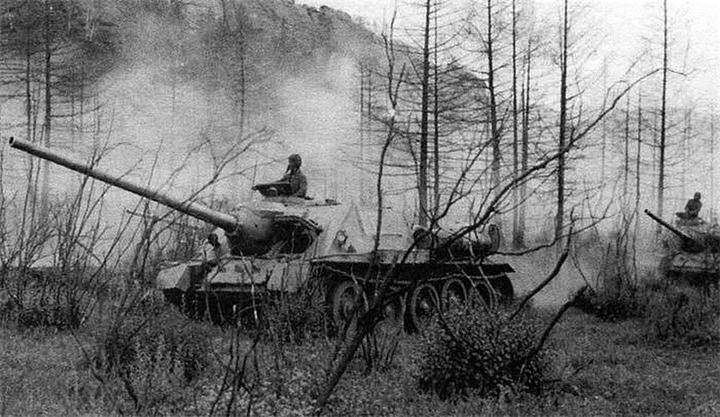
At the final stage of the war, German tanks rarely appeared on the battlefield, and the SU-100 crews mainly spent high-explosive shells. However, in conditions where it was possible to precisely aim the gun, the 100-mm high-explosive fragmentation shell UOF-412 showed good effectiveness against field fortifications, enemy manpower and lightly armored vehicles, significantly surpassing the high-explosive and fragmentation effect of the 85-mm grenade UO-367 . Cases were recorded when German medium tanks PzKpfw.IV were shot down with 100 mm fragmentation grenades when firing at ranges up to 4000 m. Apparently, we are talking about damage to the chassis with a close gap of a powerful projectile weighing 15,6 kg, containing 1,46 kg of explosives. However, with a direct hit on board, a relatively thin 30 mm “four” side armor could also be pierced.
As for the armor-piercing ability of the D-10S gun when firing an armor-piercing-tracing projectile BR-412, it turned out to be quite satisfactory. The projectile weighing 15,88 kg had an initial speed of 897 m / s and at a distance of 1500 m it pierced 115 mm armor normally. At a distance of 1000 m, when meeting at a right angle, a 100-mm shell pierced a 135-mm armor plate. The shelling of captured tanks at the training ground showed that a 100-mm cannon pierces the frontal armor of the Tiger and Panther at a distance of up to 1500 meters. The side armor of the heaviest serial German tanks, not exceeding 82 mm, as well as the frontal armor of the main mass medium PzKpfw.IV tanks and StuG.III / IV self-propelled guns, made their way from a distance of 2000 meters or more. Thus, the armor penetration of D-10S at real combat distances allowed it to confidently hit the frontal armor of most German tanks and self-propelled guns.
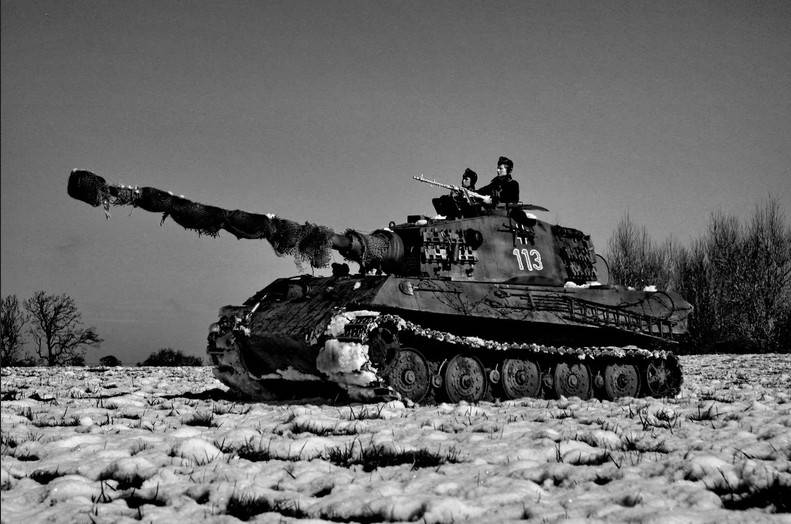
Formally, protection against 100-mm armor-piercing shells at a distance of more than 500 m was provided by the frontal armor of the PzKpfw VI Ausf heavy tank. B. Tiger II, as well as heavy tank destroyers Panzerjäger Tiger Ausf. B and Sturmkanone mit 8,8 cm StuK 43. But due to the acute shortage of alloying metals, the Germans were forced to use high-hardness armored steel in the second half of the war, and the armor of the Tiger-II and self-propelled guns “Yagdtigr” cracked and gave internal chips affecting crew and equipment. Due to the small number of built specimens, the heavy self-propelled guns Ferdinand self-propelled guns did not significantly affect the course of hostilities and, if they appeared on the battlefield, were destroyed by concentrated artillery fire.
Self-propelled artillery SU-100 appeared too late and could not fully demonstrate its high anti-tank potential on the fields of the Second World War. By April 1945, inclusive, the industry handed over 1139 self-propelled guns. But their use was largely constrained by manufacturing defects and problems with the chassis. In the spring of 1945, it was possible to cure most of the "children's ills," but the war in Europe soon ended.
Serial production of the SU-100 continued in the postwar period. In addition to Sverdlovsk, the SU-100 was produced in Omsk, until the beginning of 1948 a total of 3241 cars were built. In the post-war period, Czechoslovakia received a license for the SU-100, where in the period from 1953 to 1956 another 770 self-propelled guns of this type were produced. Self-propelled guns SU-100 were actively exported and participated in a number of local conflicts.
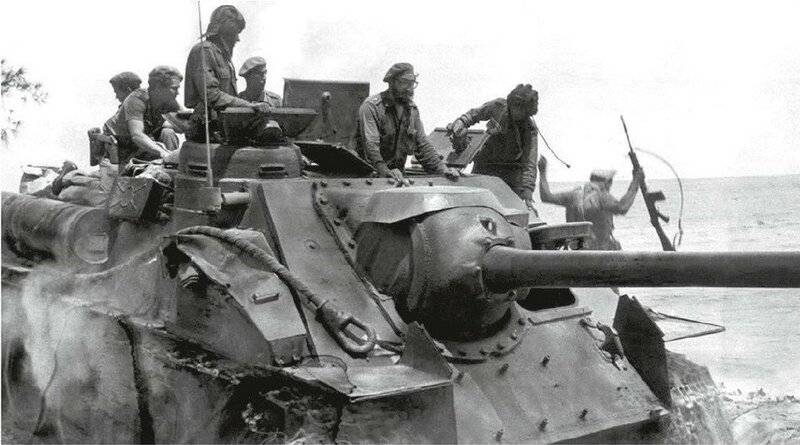
In our country, the SU-100 was actively operated until the second half of the 1970s, after which it was stored until the second half of the 1990s. The longest service of anti-tank self-propelled guns lasted in the Red Banner Far Eastern Military District. Machines built on the T-34 chassis showed better cross-country ability on soft soils than the T-55 and T-62 tanks, which was important in a vast territory with numerous swampy floodplains and taiga gauze.
The SU-100 was also noted in the cinema. In the film “At War as at War”, shot in 1968 according to the novel of the same name by Viktor Kurochkin, this self-propelled gun depicted SU-85, which in the late 1960s was no longer in good condition in the USSR.
Analysis of anti-tank capabilities of Soviet self-propelled guns
In the final part of the cycle devoted to the anti-tank capabilities of self-propelled artillery, we will try to find out which Soviet self-propelled guns were best suited for the role of a tank destroyer. As already mentioned in a previous publication on the SU-152 and ISU-152, these machines are most often called "St. John's wort". Another question: how fair is this?
It is clear that the hit of a 152-mm armor-piercing or even high-explosive fragmentation shell usually ended fatally for any serial object of German armored vehicles. However, in practice, the duel situation with the Tiger or Panther was conceived not in favor of the crew of the Soviet self-propelled guns. A heavy self-propelled gun equipped with an ML-20S gun, which was a tank version of the 152-mm howitzer-gun mod. 1937, primarily intended for the destruction of long-term fortifications and fire support of tanks and infantry. With the powerful striking effect of the shell, the "howitzer" origin made itself felt. The range of a direct shot at a target with a height of 3 m was 800 m, and the separate-shell loading in combat conditions did not allow more than 2 shots per minute.
The ISU-152, armed with a 122-mm D-122S gun, had a much greater firing range compared to the ISU-25. In this artillery system, the direct range of a target with a height of 3 m was 1200 m, and the effective range of armored vehicles was up to 2500 m. At a distance of 1000 m, a 122-mm armor-piercing projectile 53-BR-471 when shot at an angle of 60 ° pierced 108- mm armor, which made it possible to confidently destroy enemy heavy tanks. Due to the deterioration of the quality of German armor at the final stage of the war, 122-mm shells showed higher efficiency. There have been cases when the Panthers failed after hitting the frontal projection at a distance of up to 2500 m. However, for the tank destroyer the self-propelled guns ISU-122 had an insufficiently high rate of fire - 1,5-2 rounds / min. The problem of increasing the rate of fire was partially solved after installing the D-122C gun with a dual-chamber muzzle brake on a modernized self-propelled gun ISU-25C. A more convenient crew location in the fighting compartment and the use of a semi-automatic gun shutter contributed to an increase in the combat rate of fire up to 3-4 rounds / min, which, however, was still less than that of German tanks and anti-tank guns armed with 75-88-mm long-barreled guns.
In this regard, against the background of the ISU-122/152, the SU-100 looked more advantageous, the gun of which could make up to 6 aimed shots. Although the 122-152-mm self-propelled guns had some advantage in armor penetration, in practice, the effective range of heavy tanks from 1400-1500 m with an armor-piercing shell fired from the D-10S was quite enough.
A fairly indicative criterion is the fire performance of the Soviet 85-152-mm self-propelled guns used at the final stage of the war. The SU-85, armed with an 85-mm D-5C cannon, could launch up to 8 armor-piercing shells with a total mass of 76,3 kg per minute at the enemy. The SU-100, having fired 6 rounds per minute, rained down on the enemy 95,28 kg of hot metal and explosives. SU-122 per minute could release 2 armor-piercing shells with a total mass of 50 kg. ISU-122S, equipped with a more rapid-fire gun D-25S, per minute fired up to 4 shells with a total weight of 100 kg. ISU-152, armed with an ML-20S howitzer, giving an average rate of fire of 1,5 rounds / min, while firing armor-piercing shells - 73,2 kg. Thus, the fire-performance champions are the SU-100 and ISU-122S, and the worst results are demonstrated by the SU-122 and ISU-152, armed with piston-locked guns. Against the background of the 122-152-mm self-propelled guns, the SU-85 with a relatively low-powered gun looks very worthy.
It should also be noted that the SU-100, created on the basis of the T-34, was much cheaper to manufacture than heavy self-propelled guns built on the chassis of the IS-85 tank. Formally, the security of the ISU-122/152, covered in front by 60-90 mm armor, was higher than that of the SU-100, protected in front by 75 mm armor. However, in reality, the difference in security was not so obvious. The slope of the frontal 90-mm armor of the ISU-122/152 wheelhouse was 30 °, and on the SU-100 the frontal armor was tilted at an angle of 50 °, which in terms of projectile resistance gave approximately the same 90 mm. Such armor at a distance of more than 500 m well protected from Pzgr 39 armor-piercing shells fired from a 75-mm gun 7,5 cm KwK 40 L / 48, which was installed on the modernized “four”. At the same time, the German 75-mm tank gun 7,5 cm KwK 42, which was mounted on the Panther, with the Pzgr 39/42 armor-piercing tracer, could penetrate the ISU-122/152 armor at a range of up to 1500 m. German 75-mm rate of fire tank guns was 5-8 rds / min. In the event of a direct collision with heavy German tanks at real battle distances, speed and mobility were more important than protection. It was more difficult to get into the more maneuverable SU-100, since it was 122 mm lower than the ISU-235, and the difference in height of the SU-100 with the ISU-152 was 625 mm.
It can be stated that the SU-100, well adapted for mass production, was the most optimal anti-tank self-propelled gun, which had a high rate of fire and decent data on penetration of armor with satisfactory security and good mobility. At the same time, we can conclude that the anti-tank capabilities of the D-10S gun during the war were not fully realized due to the lack of armor-piercing shells that were modern by the standards of it. Tungsten carbide-tipped shells for Soviet tank and anti-tank guns were developed only in the post-war period.
No matter how offensive it may be, it should be recognized that our designers and industry in terms of the creation of tank destroyers did not keep pace with the needs of the army. This fully applies to the SU-85, SU-100 and ISU-122S. By the summer of 1943, due to the increased security and firepower of German medium tanks and self-propelled guns based on them, the Red Army experienced an urgent need for a self-propelled gun armed with an 85-mm anti-aircraft gun. Given the fact that the SU-85 was created on the basis of the SU-122, launched into serial production at the end of 1942, this machine could appear much earlier. It was the SU-85 that actually became the main Soviet tank destroyer, which destroyed much more German tanks than more advanced self-propelled guns. By the time the SU-100 and ISU-122C appeared in noticeable numbers in the Red Army, the Panzerwaffe ridge was actually broken, and these vehicles did not have a significant impact on the course of the war.
- Linnik Sergey
- Soviet self-propelled guns against German tanks in the initial period of the war
Antitank capabilities of Soviet 76,2 mm self-propelled artillery mounts
Antitank capabilities of Soviet 122 mm self-propelled artillery mounts
Antitank capabilities of the Soviet self-propelled artillery mount SU-85
Anti-tank capabilities of the Soviet self-propelled artillery systems SU-152 and ISU-152
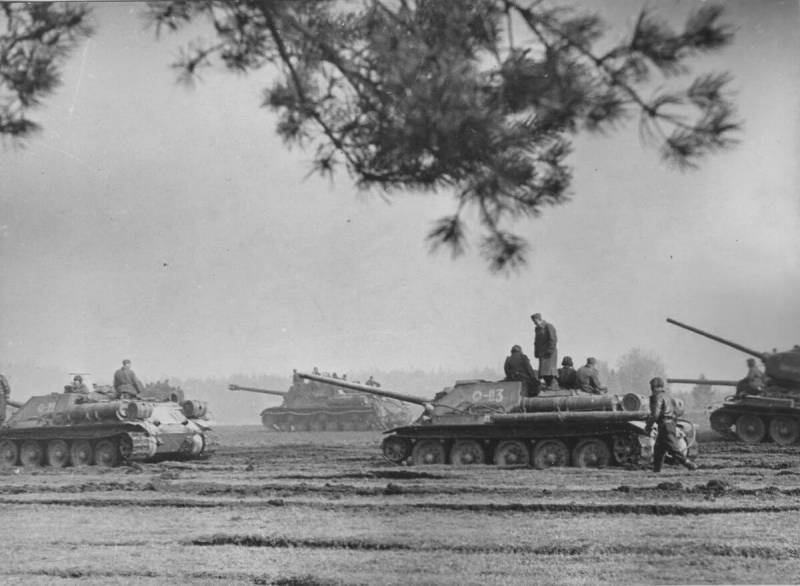
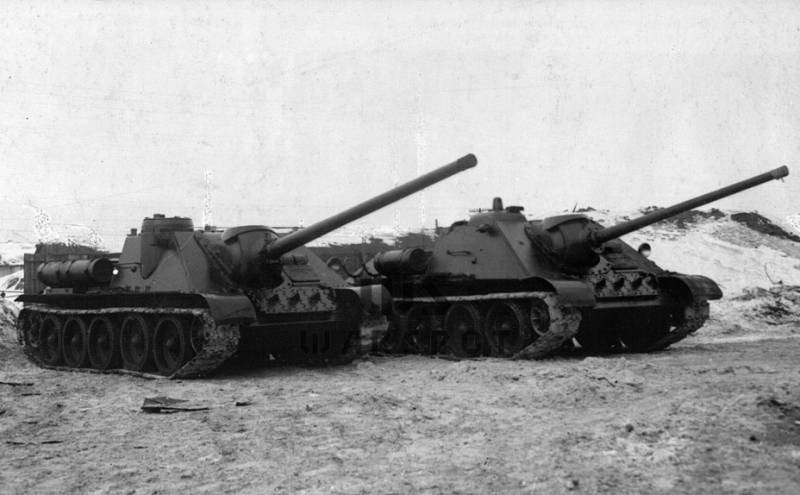
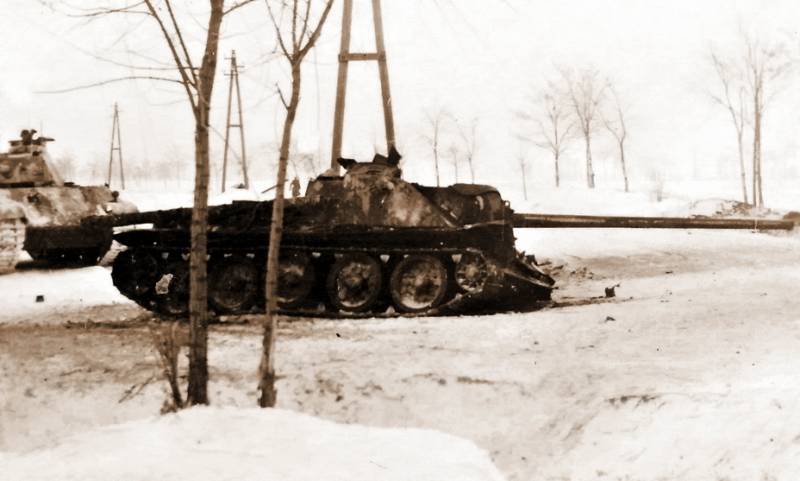
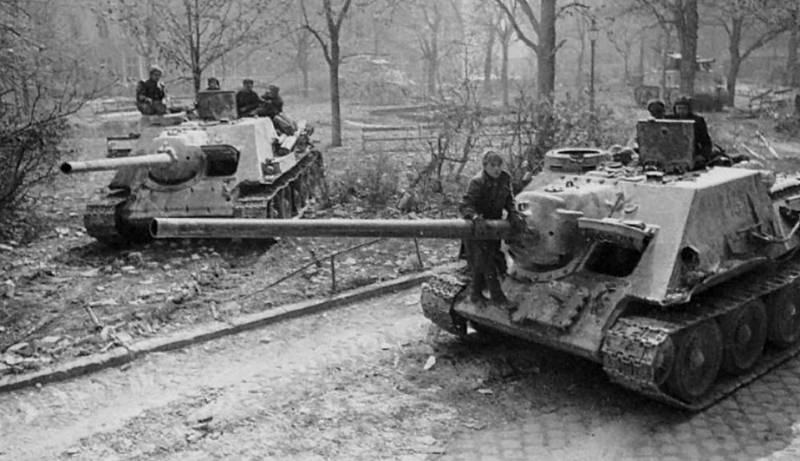
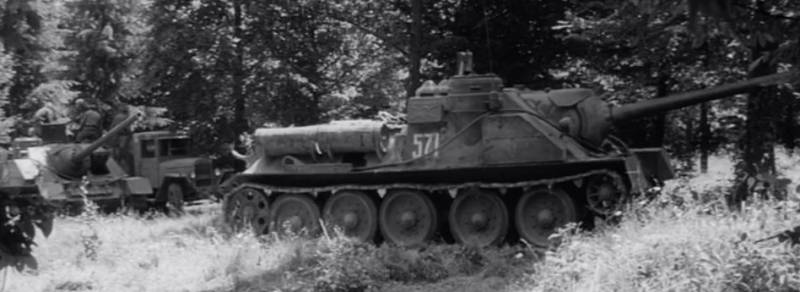
Information